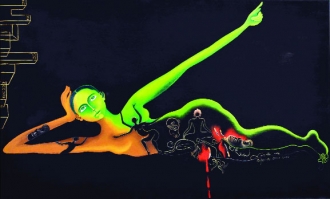Bringing the works of contemporary artists to the front – all thanks to the songs of the Uncaged Bird at NGMA.
Songs of the Uncaged Bird is a show that traces not just about the contribution of women in contemporary Indian art, it is a tribute to women artists in the nation,” says Adwaita Gadanayak, Director-General NGMA Delhi, who has put together an empowering collection for the first time under one roof. “When you look at the sculptures of Meera Mukherjee, you realise that she was setting a foundation for contemporary art practices. I also found brilliant works of Leela Mukherjee and Uma Siddhanta from Bengal,” he adds.
In the monumental maze-like rooms of the old building at Jaipur House in Delhi, the mélange of 66 works that celebrates the women artists of the nation, Songs of the Uncaged Bird holds within it infinite stories. One has to begin with the avant garde artist who pioneered modernism in the early 20th century, Amrita Shergil. Celebrating her achievements and contribution to modern Indian art, the Central Government recognised her as a national treasure artist in 1976. The majority of Shergill’s works are at the National Gallery of Modern Art in New Delhi and these are among the 172 documented works from the artist’s oeuvre. It is, therefore, a historic moment to look at her three works here in this majestic collection.
Sculptural richness
Gadanayak mention of Meera Mukherjee aptly shows that she is both worthy of scrutiny as well as intense admiration. The two sculptures here are inversely proportional in height and their dimensions affirm the brilliance and intellectual superiority that she enjoyed in the language of her creations.
The large sculpture Spirit of Work and the small sculpture both exemplify resonance personified. Mukerjee created works that embody the power of pathos and the beauty within India’s humblest workers — the tribals whom she extolled as extraordinary beings of gravitas. These two works portray the brilliance of Mukherjee and exemplify the poetic cadences that are distilled in the ideation of composition and expressionist idioms. Both these works bring back the words of critic Maitrayi Chatterjee when she wrote: “Passion goaded her creativity and expressed itself in her work, which for her was worship. She exemplified the Keatsian concept, ‘the poetry of the earth is never dead.’” Among the many sculptures on view are the brilliance of Laitka Katt, Rita Dutta, Mrinalini Mukherjee, Leela Mukherjee, Pilloo Poochkan Wala, Shirin Jalvirjee and Uma Siddhanta.
Poochkanwale’s Teeming Millions is evocative. Shirin Jalvirjee’s portrait of Win min Than, the Burmese actress, is an expression of calm serenity. Leela Mukherjee’s Dancer is a minimalist rendition of graceful lines and balance — if the rough rough-hewn edges tell us about simplicity, it is her pot form that adds to the brilliance of composition and the fragility of the life lived.
Sculptor Rita Dutta’s Ganesh Jamai is a statement that extols the richness and strength of India’s religious and mythic traditions. The essence of expression in organic sensibilities comes to the fore in Uma Siddhanta leafed car called Of Mortality an Eternity. Siddhanta was the pupil of Prodosh Dasgupta and this work exudes a love for nature as well as the gravitas of conception when you see that an object such as a car can be translated into the leaves and textures of the botanical kingdom. Sidhanta’s sculpture was the mascot for the invitation card that celebrated 63 years of the founding of the NGMA last year.
Caur and Menon
Among paintings, there are two gems in Anjolie Ela Menon’s Mata Ji, a singular portrait in shades of ochre and Arpana Caur’s surreal Dharti. Caur is feminine and feminist in its perspective, with portraits of women placed in a contemporary urban context. The erotic is downplayed in favour of the sturdy: Gayatri Sinha states that in her paintings, “There is no hint of an expressive sexuality; woman and nature are both symbiotically tied in a circle of perceived threat and uncertain renewal.” The other major concerns in her work, include time, life and death, the environment and the violence of man on man (like Hiroshima, the Partition of India, and the 1984 massacre of the Sikhs). She has created several large non-commercial murals on subjects relating to the environment in Delhi, Bangalore and Hamburg. Caur’s work responds to the surroundings and events of her life, from the crowded Patel Nagar of her childhood to events such as the rape of Maya Tyagi and the widows of the Chasnala mining disaster.
Writer: Uma Nair
Courtesy: The Pioneer








 OpinionExpress.In
OpinionExpress.In















Comments (0)